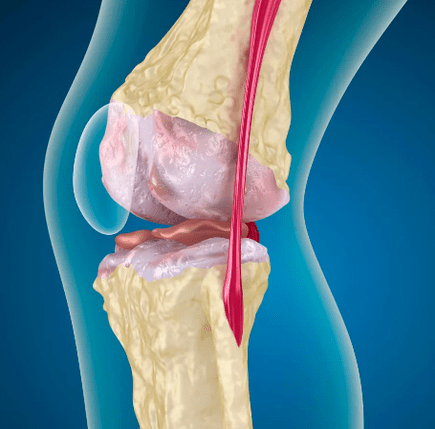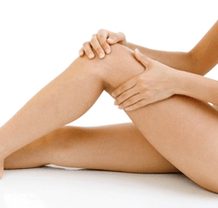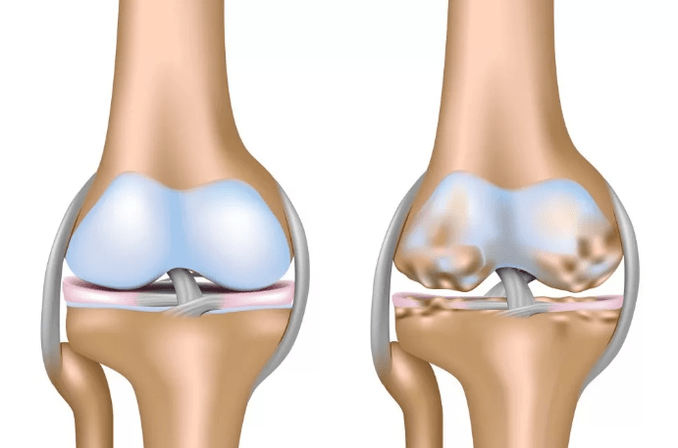The arthrosis of the knee joint is a very common disease in which, due to metabolic disorders in patients (primary arthrosis), infectious arthritis and injuries (secondary arthrosis), a number of anatomical changes in the tissues of the joints are observed.
Symptoms and degree of arthrosis of the knee joint
With arthrosis of the knee joints of the first degree, the joints move already limited in one direction and in a slight extent.With such arthrosis, swelling does not appear on the joints, the skin color in the joint does not change, temperature reactions are absent.The main symptoms in this case are weak pains in the joints, tingling, and a crunch can also be observed in the joints.

With arthrosis of the knee joints of the second degree, as well as with arthrosis of the shoulder joint, the symptoms are more pronounced.This type of arthrosis is the most common.Patients with a second degree disease usually complain of fatigue, feel pressure and tension in the joints, complain of pain during and after physical exertion, fatigue and pain in the joint after and during the raising of heavy objects, long walking.Also, the symptoms of arthrosis of the second degree are crusts in the knee joints, difficulties in the flexion/extension of the knee.With second -degree arthrosis, the joints begin to deform.
Symptoms of arthrosis of the third degree are pain in the joint, very sharp, causing inconvenience to the patient even at rest.A person cannot choose a convenient pose, so at this stage of the disease it is very difficult for him to fall asleep.Damaged joints tends to show reactions to changes in weather conditions, the joints are almost not bent.
Treatment of arthrosis of the knee joint
You can treat arthrosis of the knee joint with non -steroidal anti -inflammatory drugs.With arthrosis by non -steroidal, i.e.Not hormonal, anti-inflammatory drugs are traditionally used to eliminate inflammation and pain, because due to severe pain there is no way to start treatment.Only after the pain is eliminated by anti -inflammatory drugs, you can proceed to massage, a complex of therapeutic exercises and physiotherapeutic procedures.
But such drugs should not be used for a long time, since they can “disguise” the manifestation of the disease, or, as doctors say, relieve symptoms.When the pain decreases, a deceptive impression is created that the joint begins to be cured.And arthrosis at this time continues to progress.Therefore, NSAIDs are able to eliminate the symptoms of the disease, and not treat it.
You can also use Chondroproprotectors in the treatment of arthrosis.Chondroprotectors are substances that can feed cartilage tissue, and restore the structure of the damaged joint.These are the most useful drugs for the treatment of arthrosis.
Chondroprotectors have the ability to eliminate the causes of the disease.When using drugs such as chondroitin sulfate and glucosamine, the restoration of the cartilage surfaces of the joints is observed, the production of lubricant fluid improves, and the normalization of its properties.
Among other things, you should use therapeutic creams and ointments in the treatment of arthrosis.Ointments and creams do not heal the arthrosis of the knee joint, but they can reduce the pain in the knee and improve the patient's condition.Also, many ointments help improve blood circulation in the joints.

In order to improve blood circulation in the knee joint, you should use ointments.With the help of such ointments, the patient will achieve comfort and pleasant heat.There will be no side effects (with rare exceptions).
Also, for the treatment of arthrosis of the knee joints, non -steroidal anti -inflammatory ointments should be used.Such ointments are used in case of deepening gonarthrosis by synovitis phenomena.
Do not neglect various types of compresses.After all, the funds.used for compresses, there is a more effective therapeutic effect, unlike ointments.
You can not ignore injections (intra -articular).
Intra-stratum injections are used in the provision of emergency medical care in the case of arthrosis of the knee.Often to use such a method as intra -articular injections is not recommended, although often you have to resort to it, because the patient's condition is significantly facilitated by injection.And do not forget that before the use of even the weakly acting drugs, it is necessary to consult a doctor.
The use of physiotherapy and manual therapy is also recommended.These treatment methods have practically no side effects, and therefore are more preferable.
Manual therapy is recommended for arthrosis of the joint of the first and second degree, gives a very effective positive result.
Many doctors also recommend therapy for therapeutic gymnastics.Therapeutic gymnastics is needed in order to strengthen muscles, pump blood vessels, resume blood flow to the maximum ability.The plus of this treatment method is that you do not need to spend money on various medications.You will need a small place in the room, as well as a rug or blanket on the floor.
Some types of gymnastic exercises that will help you cope with the disease: raising straightened legs in a lying position;Fighting and bending of the knee joint is not up to the stop in the lying.
Exercises for the treatment of arthrosis of the knee joints:

Deforming arthrosis of the knee joint
During a change in cartilaginous tissue, the disappearance of hyalin cartilage can be observed completely, therefore, bone exposure, growth along the periphery, and the formation of exostosis are observed.As a result of this, the knee is deformed, a disease such as deforming arthrosis of the knee joint appears.
In this case, both the conservative and the operational method of treatment are allowed.
Conservative treatment includes restrictions on physical exertion on affected joints, swimming, physiotherapy exercises, the use of medicines (non -steroidal anti -inflammatory drugs, analgesics, corticosteroids and other drugs).
Surgical treatment involves arthroscopy of the joint joint (this is an endoscopic therapeutic and diagnostic operation).In this case, the destroyed fragments of cartilage, meniscus and other damaged structures are removed.















































